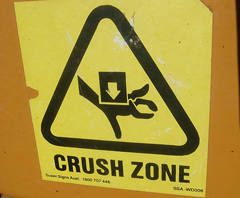
Crush injuries occur when a part of the body – such as a hand, arm, leg, foot or trunk is trapped, pinched or jammed under or between objects. The pressure can harm skin, muscles, nerves or bone, depending on the degree of force. In some cases little damage is seen on the outside as the damage is hidden on the inside.
Crush incidents are often horrific events that result in death or life-long consequences for workers, their families and communities. Crush injuries range from hitting a finger or thumb with a hammer, to the deadly impact of unsafe use of modern machinery, falling hay bales, or quad bike rollovers.
Crush injuries are common on farms, particularly those involving the hands. The most serious cases occur in agriculture where heavy machinery is used and people become trapped under them or in them.
Crush injuries can happen:
- During tractor and quad bike rollovers, with the main causes of death from quad rollovers being asphyxiation, crushing and head injuries.
- While using heavy equipment.
- When moving large hay or wool bales and they fall.
- While dealing with large animals in yards or small spaces.
- During logging or cutting firewood.
- While moving farm equipment.
- Operating vehicles without a driver (for example feeding out alone).
Crush injuries can cause compartment syndrome or crush injury syndrome which both have serious consequences. Both require urgent medical attention.
Compartment syndrome
Compartment syndrome can occur when muscles inside the ‘compartment’ of a limb swell so much that blood flow is blocked. The fascia, which covers the muscles, is not very elastic and does not stretch, forcing the pressure from the swelling inwards, compressing nerves and blood vessels. This compression can damage nerves and muscles, causing chronic pain and mobility issues. Compartment syndrome can be caused by many things including being crushed under a heavy object.
Crush injury syndrome
Crush injury syndrome occurs when a large area of muscle is compressed and starved of blood flow over several hours. This causes the muscle cells to break down, releasing acids and other chemicals. When the pressure is removed these chemicals are released and can cause serious damage as they travel to the heart and kidneys.
First aid
First aid for crush injuries requires careful assessment. If the area has been compressed for a long time it may be best to wait for emergency services to arrive or seek advice when you call triple zero (000), before removing the crushing weight, as a tourniquet or intravenous fluids may be needed before the weight is released.
However, if the weight on the head, chest, neck or abdomen is not removed the casualty may die from breathing failure, heart failure or blood loss. Even if not apparently badly injured internal damage or rapid deterioration can occur. Seek medical attention.
Visit Better Health Channel for more information and suggestions to prevent crush injuries involving tractors, quad bikes, machinery, grain augers and livestock.
Fast facts:
- Crush injuries, where part of the body is squeezed between or under a heavy object, are common on farms and can be serious.
- Crush injuries can cause broken bones (fractures) bruising and bleeding.
- Crush injury syndrome occurs when a large area of muscle is squashed – this requires careful first aid. Call triple zero 000 immediately for advice before you ‘free’ the person.
References used for this topic
More information:
Safe Work Australia
Key Work Health and Safety Statistics Australia 2024
Some steps to reduce risk of death from cattle crushing [PDF]
Clinical care:
Practical Plastic Surgery For Nonsurgeons (Chapter 35)
Hand crush injury and compartment syndrome [PDF]
ANZCOR Guidelines
Guideline 9.1.7 – First Aid Management of Crush Injury
Research & reviews:
Safe Work Australia
Work-related hand and wrist injuries in Australia [PDF]
Farming Ahead
Avoiding and treating Crush Injuries (2016) [PDF]
|
|